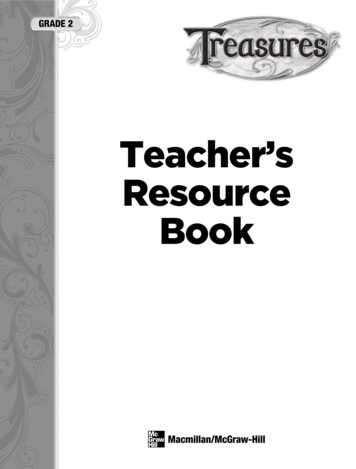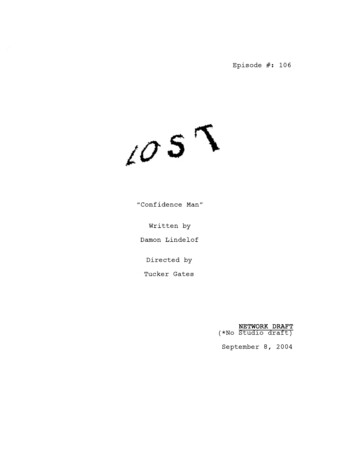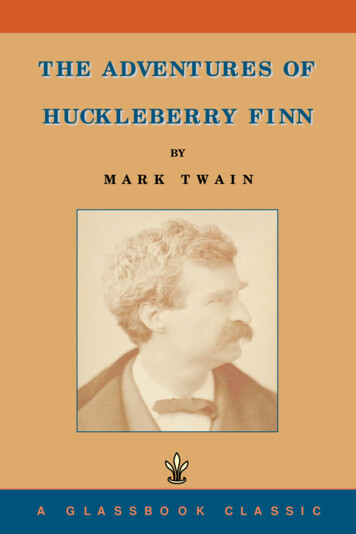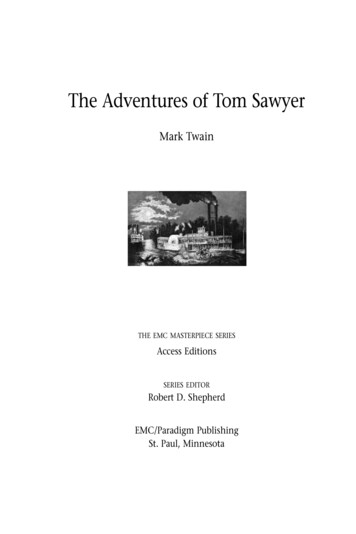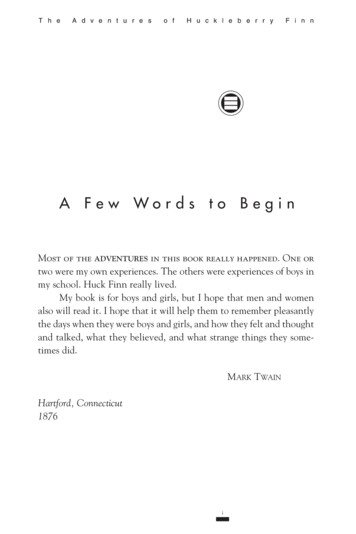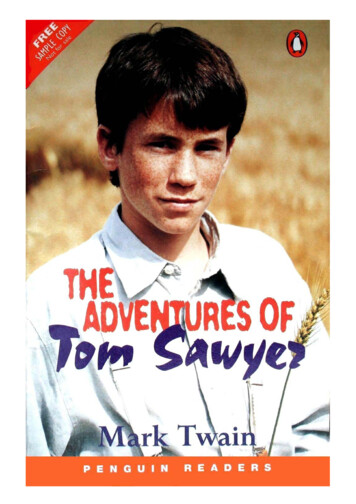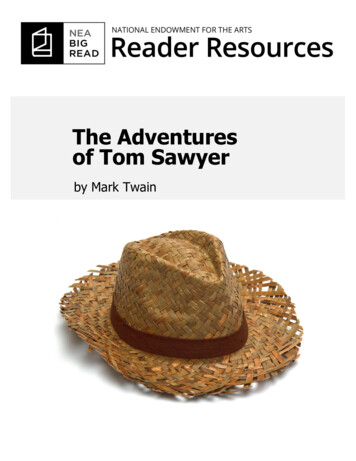
Transcription
The Adventuresof Tom Sawyerby Mark Twain1
Table of ContentsThe Adventuresof Tom SawyerAbout the Book. 3About the Author . 5Historical and Literary Context . 6Other Works/Adaptations . 7Discussion Questions. 9Additional Resources . 10Credits . 11PrefaceThe Adventures of Tom Sawyer is not merely a literaryclassic. It is part of the American imagination. More than anyother work in our culture, it established America's vision ofchildhood. Mark Twain created two fictional boys, TomSawyer and Huck Finn, who still seem more real than mostof the people we know. In a still puritanical nation, Twainreminded adults that children were not angels, but fellowhuman beings, and perhaps all the more lovable for theirimperfections and bad grooming. Neither American literaturenor America has ever been the same.“The differencebetween the almostright word & the rightword is really a largematter—it’s thedifference betweenthe lightning bug andthe lightning.”What is the NEA Big Read?A program of the National Endowment for the Arts, NEA BigRead broadens our understanding of our world, ourcommunities, and ourselves through the joy of sharing agood book. Managed by Arts Midwest, this initiative offersgrants to support innovative community reading programsdesigned around a single book.A great book combines enrichment with enchantment. Itawakens our imagination and enlarges our humanity. It canoffer harrowing insights that somehow console and comfortus. Whether you’re a regular reader already or making upfor lost time, thank you for joining the NEA Big Read.NEA Big ReadThe National Endowment for the Arts2
About the BookIntroduction tothe BookMark Twain's The Adventuresof Tom Sawyer (1876) is abook for readers of all ages.Most readers pick it up youngand enjoy it, but too few comeback to it later on, when itsdark shadings and affectionatesatire of small-town life mighthit closer to home.The book sold slowly at firstbut has since become thearchetypal comic novel ofAmerican childhood. It begins with several chapters ofscene-setting episodic skylarking by Tom and his gang. Allthe grown-ups in the book fret about Tom, fussing at himabout his clothes and his manners, but also about his future,and whether this orphaned boy can ever grow up right.Meanwhile, Tom just wants to cut school, flirt with the newgirl, get rich, and read what he pleases. Only after he andhis wayward friend Huckleberry Finn accidentally witness amurder will he at last get the chance to live out anadventure as heroic as any in his storybooks. When Tom andhis beloved Becky Thatcher become trapped in a dark cave,he must call on all his imagination and ingenuity if he wantseven a chance at growing up.The Adventures of Tom Sawyer has likely suffered over theyears from unfair comparisons to its famous sequel. Huckgets fuller development in Adventures of Huckleberry Finn(1885), where he escapes down the river with the runawayslave Jim and, in spite of himself, begins to discover hisconscience. But just because Huckleberry Finn is the deeperbook doesn't make Tom Sawyer mere kids' stuff. Twainnever could make up his mind whether Tom Sawyer was forkids or grown-ups, and his book is the better for it.If Tom stepped out of his nineteenth-century Missouri smalltown and into a contemporary American classroom, aguidance counselor would probably tag him as an at-risklatchkey kid. Reading Tom Sawyer today is an invitation totalk about how American childhood has and hasn'tchanged—and also to laugh at Twain's enduring invention ofa great American comic voice."Now the raft was passing before the distant town. Two orthree glimmering lights showed where it lay, peacefullysleeping, beyond the vague vast sweep of star-gemmedwater."—from The Adventures of Tom SawyerNEA Big ReadThe National Endowment for the ArtsMajor Characters in the BookThe KidsTom Sawyer is a smart, imaginative, conniving, bossy boygrowing up in fictional St. Petersburg, Missouri. He's usuallyin trouble by the time he gets out of bed, but he's too wellmeaning and funny for anybody to stay mad at him for long.Huckleberry Finn is the son of the local drunk. Huck doesmost everything that Tom puts him up to, while Tom covetsHuck's freedom and independence.Becky Thatcher is the new girl in town, and Tom falls hardfor her. She's flirty and headstrong, sometimes manipulative,but brave enough with Tom by her side.Sid Sawyer, Tom's half-brother, is the most disgustinggoody two-shoes on two legs. Aunt Polly is alwaysmeasuring Tom against him even though he's a shamelesstattletale, a worrywart, and a crybaby.The AdultsAunt Polly has taken care of Tom since his mother died.She truly loves him, but he's a handful, and she wishes hecould be more like that nice Sid.The Widow Douglas takes Huck into her home and tries toreform him. Her rigidly scheduled life rubs him the wrongway, and only Tom has any luck talking him into staying.Muff Potter is a drunkard. He's not an evil man exactly butweak, cowardly, and ripe for anyone to come along and takeadvantage of him.Injun Joe embodies all the fear of the unknown that asmall town might feel on the edge of a great unsettledwilderness. Violent and cruel, he earns a little of the reader'ssympathy only at the very end.Tom Sawyer and Huckleberry FinnMark Twain's two most enduring books, Adventures ofHuckleberry Finn and its often underrated junior partner TheAdventures of Tom Sawyer, represent two sides of the sameraft. Tom Sawyer is sunny and upright, skirting whirlpoolsbut ultimately hugging the shore of convention. Huck Finn isits deep, dark, wet, rushing underside. Nowhere do theseflipsides of Twain's productively riven personality bob upmore conspicuously than at two moments common to eachnovel: when both title characters attend their own funerals,and when each novel ends with a shaky vow of reform.3
In both books the hero gets to live out perhaps everymorbid, underappreciated kid's greatest fantasy: to spy onhis own mourners and hear how sorry everybody is, andthen to come back from the dead to a hero's welcome. "Shewould be sorry some day," Tom says of Becky, "maybewhen it was too late. Ah, if he could only die temporarily!"Typically, Tom lucks into his version of this fantasy. Huck, onthe other hand, deliberately fakes his own death to escapehis father.The books' endings, too, are strikingly similar. In TomSawyer, Huck reluctantly allows the Widow Douglas to takehim in, but on the last page he doesn't sound terriblyoptimistic about sticking it out with her. Meanwhile, in thefamous ending to Huck Finn, the title character vows to"light out for the territory" if the widow tries too zealously to"sivilize" him, because he's "been there before." Huck hasindeed been there before, because Tom Sawyer ended onthis same skeptical note.In fact, Tom and Huck fit their namesake books perfectly.Like Tom, The Adventures of Tom Sawyer is outrageous, butalso smooth, artful, and anxious to please. A model ofliterary construction, it stands up straight. Like Huck, on theother hand, Adventures of Huckleberry Finn slouches. It'sungainly, in need of finishing, and its language often lands itin trouble. It's also touched by genius. There's no denyingthat something's fundamentally haywire with the end ofHuck Finn––yet look closer and see if it isn't a flaw commonto every imperfect life. Huck and Jim have gone wrong afterthe fork, they've overshot something crucial, they've losttheir way and don't know how to get back. Who among ushasn't felt the same? Twain certainly should have. Hepublished his best book at 50 but lived to nearly 75.Seen this way, Tom and Huck's Mississippi River becomes anendlessly renewable metaphor. Twain saw as clearly asanybody that as Americans we're all on this raft together,afloat between oceans, crewed by oarsmen of more thanone color, tippy but not aground, not yet.NEA Big ReadThe National Endowment for the Arts4
About the AuthorMark Twain(1835-1910)Mark Twain was a man aheadof his time from the day hewas born Samuel LanghorneClemens, fully two monthsearly, in tiny Florida, Missouri.Not surprising for a preemie,a profound sense of mortalityshadowed him all his life. Inaddition, Twain survived ayouth marked by deaths bothsudden and grisly.Not only did his forbiddingMark Twain, 1867 (Library offather, Judge John MarshallCongress)Clemens, die of pneumoniawhen Twain was eleven, butTwain is said to have witnessed the autopsy through akeyhole. He also sat at his beloved brother Henry's bedsideas he lay dying after a steamboat explosion, and Twainforever blamed himself for getting Henry his fateful job onboard.Three other formative experiences made Twain the writer hebecame. First were the gifted storytellers he grew uplistening to, many of them slaves. Next came his early job asa printer's apprentice. There he literally put words together,by handsetting type, and observed up close what madesentences sing or clang. Finally came Twain's years inCalifornia and Nevada, where he became a newspapermanand found his voice as a writer. There he chose the penname "Mark Twain," a riverboat expression meaning twofathoms deep, the divider between safe and dangerouslyshallow water. A tall tale called "The Celebrated JumpingFrog of Calaveras County" (1865), widely reprinted almostimmediately, cemented his national reputation.Twain returned from the West and set out for the East—specifically the Middle East, where he traveled on the firstever luxury cruise and filed dispatches back to statesidenewspapers. The eventual result was a national bestseller,The Innocents Abroad (1869), and highbrow acceptancefrom the tastemakers at The Atlantic Monthly magazine.Meanwhile, Twain's personal life settled down. After years ofbachelorhood he married Olivia "Livy" Langdon, whom hehad first glimpsed in a cameo carried by her brother,Charley, on shipboard. Charley introduced the couple ontheir return, and after two years Twain overcame theLangdons' misgivings and they married. She was demureand he was outrageous, but somehow it worked. After theNEA Big ReadThe National Endowment for the Artsdeath of their firstborn son, they raised three daughters andlived as happily as Twain's dark moods permitted.Twain's imperishable memories of his boyhood led to thewriting of The Adventures of Tom Sawyer (1876) and,eventually, its more challenging sequel, Adventures ofHuckleberry Finn (1885). Twain wrote well and prolificallyalmost all his long life, but these two companion piecesstand apart as his masterpieces of childhood and childhood'send.Financial uncertainty and death haunted Twain's last yearseven more than they had his first. He went broke keeping upthe beautiful house he had built in Connecticut and investingin a series of harebrained schemes. A daughter died, thenhis adored but frail Livy, and then yet another daughter.Through it all he kept writing—fiction when he could, essayswhen he couldn't, plus magnificent letters and journals bythe trunkful. Revered across America and around the world,Twain died on April 21, 1910.Twain on Writing"God only exhibits his thunder and lightning at intervals, andso they always command attention. These are God'sadjectives. You thunder and lightning too much; the readerceases to get under the bed, by and by."—from an 1878 letter to his brother Orion"There is no such thing as ‘the Queen's English.' Theproperty has gone into the hands of a joint stock companyand we own the bulk of the shares!"—from Following the Equator, 1897"No sir, not a day's work in all my life. What I have done Ihave done because it has been play. If it had been work Ishouldn't have done it."—from a 1905 interview"I never write ‘metropolis' for seven cents, because I can getthe same money for ‘city.' I never write ‘policeman,' becauseI can get the same price for ‘cop.'"—from a 1906 speech, "Spelling and Pictures"5
Historical and Literary ContextThe Life and Times of Mark Twain1830s1880s 1882: After the Civil War ends, Twain embarks on aresearch trip for Life on the Mississippi. 1835: Halley's Comet streaks across the night sky. 1835: Samuel Langhorne Clemens, who later adoptsthe pen name Mark Twain, is born in Florida, Missouri,on November 30. 1839: The Clemens family moves to nearby Hannibal. 1885: Inspired partly by his return visit south, Twainfinishes Adventures of Huckleberry Finn. 1886: Twain buys half-interest in a typesettingmachine, which will yield him no end of grief and norate of return.1890s1840s 1847: Clemens's father dies of pneumonia. 1848: Gold discovered in California, mere weeks afterU.S. annexation of the territory in the Treaty ofGuadalupe Hidalgo. 1848: Clemens apprenticed to his older brother Orionas a printer.1850s 1894: Twain declares bankruptcy and embarks on anexhausting world lecture tour to dig himself out ofdebt. 1896: Twain's beloved daughter Susy dies. Mahatma Gandhi agitates for Indian independence;Sigmund Freud pioneers psychoanalysis; Twain meetsboth, and many other luminaries, during his travels.1900s 1858: Clemens's brother Henry dies from injuriessustained in a riverboat explosion. 1858: Comstock silver lode discovered in Nevada. 1859: Clemens gets his license to pilot steamboats onthe Mississippi River.1860s Twain writes brilliant, increasingly bitter essaysagainst lynching, war, and imperialism. 1904: Livy dies in Italy. 1905: President Theodore Roosevelt busts trademonopolies at home, pursues imperialist aims abroad,and entertains Twain at the White House. 1908: Henry Ford introduces the Model T. 1861: The Civil War begins and lasts four blooddrenched years. Clemens joins the Confederate sideand lasts all of two weeks. 1861: Clemens heads west to find his fortune anddiscovers a career in journalism instead.1910 1910: Halley's Comet returns. 1910: Mark Twain dies on April 21. 1867: As a journalist, Twain tours Europe and theMiddle East and brings back the makings of his firstbook, The Innocents Abroad, 1869.1870s 1870: Twain marries Olivia "Livy" Langdon. 1873: Greed and corruption run rampant in postwarAmerica, yielding the subject for Twain's first (cowritten) novel, The Gilded Age: A Tale of Today. 1876: The Adventures of Tom Sawyer published.NEA Big ReadThe National Endowment for the Arts6
Other Works/AdaptationsTwain and His Other WorksMark Twain started out writing just for himself—and woundup that way too. In between he attempted nearly everygenre, found success at most of them, and all butreinvented American fiction and travel literature.Twain honed his style while writing for the scrappy,bumptious broadsheets of the Western gold and silverbooms. Somewhere, in a Saratoga trunk up in the SierraNevada, probably lie as many lost Twain newspaper columnsas have already been found. Until they surface, more thanenough early newspaper sketches survive that a reader canstill watch a precocious riverfront kid turn a little more intoMark Twain with each byline.He always remained more comfortable with sprints than withmarathons. His first attempts at fiction took the form ofshort stories. What came to be called "The CelebratedJumping Frog of Calaveras County" (1865) made his name,and, even to the end of his life, Twain probably found shortfiction more congenial than the novel.Twain revolutionized travel writing with The InnocentsAbroad (1869). The book started out as journalistic letters,but he reworked, padded, and finessed them extensivelyupon his return from the Middle East. The result anticipatesthe so-called New Journalism in its insistence on the writer'sexperience as no less important than his itinerary.After the huge success of The Innocents Abroad, Twainapplied the same style to a sojourn he'd already taken.Roughing It (1872) hysterically encapsulates Twain's yearsin the West, and some of its episodes rival any travelliterature for description, characterization, and downrighthilarity.Several of Twain's last essays never saw print in his lifetime.They were blistering, so misanthropic that few would haverecognized them as the work of America's beloved whitesuited grandpa. Yet these broadsides too are Mark Twainand, for those who can take them, stand among hisstrongest work.Selected Works by Mark Twain The Innocents Abroad, 1869 (travel) Roughing It, 1872 (travel) The Adventures of Tom Sawyer, 1876 (novel) The Prince and the Pauper, 1881 (novel) Life on the Mississippi, 1883 (memoir) Adventures of Huckleberry Finn, 1885 (novel) A Connecticut Yankee in King Arthur's Court, 1889(novel) Pudd'nhead Wilson, 1894 (novel) The Autobiography of Mark Twain, 1924 (memoir) The Oxford Mark Twain, 1997 (29-volume collectionof works published in Twain's lifetime) Autobiography of Mark Twain, Vol. 1 2010, Vol. 22013 (stipulated by Mark Twain not to be publishedfor at least 100 years after his death)Some critics dismiss The Prince and the Pauper (1881) and AConnecticut Yankee in King Arthur's Court (1889) as tossoffs, written more for his daughters than for the ages. Butthe former numbers among his few durable, wellcarpentered plots, and the latter ends with surely the mostage-inappropriate bloodbath in the annals of children'sliterature.Pudd'nhead Wilson (1894) remains a fascinating curiosityand Twain's most direct consideration of slavery. The plotmachinery has a tendency to clank, but the very lack of asettled consensus about its meaning and worth makes itirresistible reading. In it Twain rewrites the switched-doublesplot of The Prince and the Pauper, only this time heemphasizes the racial tension of the era.NEA Big ReadThe National Endowment for the Arts7
Twain on Film, and ElsewhereThe perennial popularity of Mark Twain and his charactersensures a steady stream of successors to the already morethan a hundred adaptations of his work, not excludingversions of Tom Sawyer filmed in Russia, Japan, andRomania. None of these can be called a masterpiece, norcan the multiple movies of Adventures of Huckleberry Finn,The Prince and the Pauper, or A Connecticut Yankee in KingArthur's Court. But even the most wrongheaded of them cankickstart a conversation about how not to betray a belovedbook on screen, and a few have some delightfulperformances. There are also some howlingly awful ones—most attributable to child actors, cast mainly for theircuteness, trying and failing to nail Twain's anachronistic PikeCounty dialect and slang.reconceived by David Ives) but settled for popularizing theAmerican novel."All modern American literature comes from one book byMark Twain called Huckleberry Finn."—Ernest Hemingway, from The Green Hills of Africa (1935)The early 1980s brought a spate of Twain adaptations onPBS from screenwriter Philip H. Reisman, Jr., and directorPeter H. Hunt. They collaborated on a creditable Life on theMississippi (1980) followed by a Peabody Award-winningshort film of "The Private History of a Campaign That Failed"(1981) for the National Endowment for the Humanitiesunderwritten American Short Story series. Separately,Reisman wrote a well-received version of Pudd'nhead Wilson(1984), with Ken Howard of The White Shadow in the titlerole. Meanwhile Hunt directed a version of "The MysteriousStranger" (1982), something called Sawyer and Finn (1983),and, best of all, a long, stunning 1985 version of Huck Finn(take your pick between 108- and 213-minute cuts) starringSamm-Art Williams and Harry Potter audiobook reader JimDale.Twain's life has served as fodder for at least threebiographical films: Ken Burns's impeccable PBS documentaryMark Twain (2001); The Adventures of Mark Twain (1944),with Fredric March donning the white suit and fright wig;and the gold standard, Hal Holbrook's 1967 film of his oneman show Mark Twain Tonight!For the original stage version, Holbrook lovingly cobbledtogether choice stories and observations from Twain's ownwritings and lectures. After performing varying versions ofthe show for decades, he ultimately wound up with untoldhours of memorized Twain from which to choose—all thewhile puffing on Twain's ever-present cigar for punctuation.In any medium, Mark Twain Tonight! remains perhaps thebest tribute to Twain, a man who always flirted with fame asa playwright (and won it again in 2007 for Is He Dead?, asNEA Big ReadThe National Endowment for the Arts8
Discussion Questions1. How do you think American childhood has and hasn'tchanged since the 1840s?2. The Adventures of Tom Sawyer was already ahistorical novel when it was written, fully 30 yearsafter it is set. Does it feel realistic or nostalgic?3. Between Tom and Huck, who's more of an outlaw andwho's a conformist?4. Who emerges with more dimension in the book,African Americans or Native Americans? Can youdetect any hints of Twain's late-career humanism?5. How might the fence in Aunt Polly's yard serve as asymbol? What might be implied by Tom getting othersto "whitewash" the fence for him?6. How old are Tom and his classmates? Do they behaveconvincingly for their age?7. Why do you think Twain made Tom an orphan?8. Which do you enjoy more, Twain's dialogue or hisdescriptions? How does one complement the other?9. If you could eavesdrop on your own funeral, what doyou think you would hear?10.Find a sentence that makes you laugh out loud.Change one word. Is it as funny? If not, why not? Ifso, change one word at a time until the joke weakensor dies. What made it work before?11.What important roles did Huck and Becky play inTom's success, even though Tom is celebrated as thetown's hero?12.Tom makes a difficult decision when he tells the truthabout the murder. Compare the way he comes to hisdecision with Huck's choice to help Jim in Adventuresof Huckleberry Finn. How does Tom's motivation differfrom Huck's?13.Some readers believe that Tom develops a conscienceby the end of the novel. Do you agree? Is thereevidence to suggest that Tom has changed?NEA Big ReadThe National Endowment for the Arts9
Additional ResourcesWorks about Mark Twain Kaplan, Justin. Mr. Clemens and Mark Twain: ABiography. New York: Simon & Schuster, 1966. Powers, Ron. Mark Twain: A Life. New York: FreePress, 2005. Ward, Geoffrey C., Dayton Duncan, and Ken Burns.Mark Twain: An Illustrated Biography. New York:Alfred A. Knopf, 2001.If you liked The Adventures of TomSawyer, you might enjoy: John Knowles's A Separate Peace, 1959 Harper Lee's To Kill a Mockingbird, 1960 Olive Anne Burns's Cold Sassy Tree, 1981 Tony Earley's Jim the Boy, 2000Websites Mark Twain: A Film Directed by Ken BurnsThe website that accompanies the PBS film “MarkTwain,” a documentary directed by Ken Burns,includes classroom activities, selected writings, achronology of Twain's life, and links to relatedwebsites.http://www.pbs.org/marktwain/ The Mark Twain House & MuseumThe mission of The Mark Twain House & Museum inHartford, Conn., is to foster an appreciation of thelegacy of Mark Twain as one of our nation's definingcultural figures and to demonstrate the continuingrelevance of his work, life, and times.http://www.marktwainhouse.org/ The Mark Twain ProjectA collaboration between the Mark Twain Papers andProject of The Bancroft Library, the California DigitalLibrary, and the University of California Press, thiswebsite contains reliable texts, accurate andexhaustive notes, and the most recently discoveredletters and documents. Its ultimate purpose is toproduce fully annotated, digital editions of everythingMark Twain wrote.http://www.marktwainproject.org/NEA Big ReadThe National Endowment for the Arts10
CreditsWorks CitedHemingway, Ernest. Green Hills of Africa. New York: CharlesScribner's Sons, 1935.Twain, Mark. Mississippi Writings: The Adventures of TomSawyer, Life on the Mississippi, Adventures of HuckleberryFinn, Pudd'nhead Wilson. New York: Library of America,1982.---. Collected Tales, Sketches, Speeches, and Essays 18521890. New York: Library of America, 1992.---. Collected Tales, Sketches, Speeches, and Essays 18911910. New York: Library of America, 1992.The National Endowment for the Arts was established byCongress in 1965 as an independent agency of the federalgovernment. To date, the NEA has awarded more than 5billion to support artistic excellence, creativity, andinnovation for the benefit of individuals and communities.The NEA extends its work through partnerships with statearts agencies, local leaders, other federal agencies, and thephilanthropic sector.Works ConsultedKaplan, Justin. Mr. Clemens and Mark Twain: A Biography.New York: Simon & Schuster, 1966.Powers, Ron. Mark Twain: A Life. New York: Free Press,2005.AcknowledgmentsWriter: David Kipen for the National Endowment for the ArtsCover image: "straw hat isolated" by SmileStudio.Shutterstock.Arts Midwest promotes creativity, nurtures culturalleadership, and engages people in meaningful artsexperiences, bringing vitality to Midwest communities andenriching people’s lives. Based in Minneapolis, Arts Midwestconnects the arts to audiences throughout the nine-stateregion of Illinois, Indiana, Iowa, Michigan, Minnesota, NorthDakota, Ohio, South Dakota, and Wisconsin. One of six nonprofit regional arts organizations in the United States, ArtsMidwest’s history spans more than 25 years.NEA Big Read Reader Resources are licensed under a CreativeCommons Attribution-NonCommercial-NoDerivatives 4.0 InternationalLicense. Arts MidwestNEA Big ReadThe National Endowment for the Arts11
the Book Mark Twain's The Adventures of Tom Sawyer (1876) is a book for readers of all ages. Most readers pick it up young and enjoy it, but too few come back to it later on, when its dark shadings and affectionate satire of small-town life might hit closer to home. The book sold slowly at first but has si

